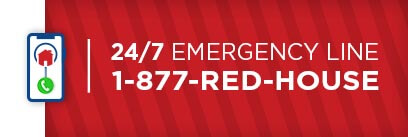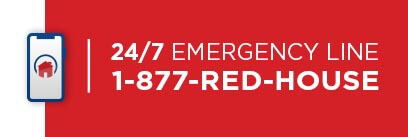
Did you know that according to the National Oceanic and Atmospheric Administration (NOAA), it only takes a wind speed of as little as 58 mph or hail as small as the size of a quarter to cause severe property damage? That’s all it takes! Many may not even know they have damage, especially if they weren’t home to witness it. Storm damage left undetected can wreak extreme havoc on your property later, costing you tens of thousands of dollars, and a whole lot of time and energy spent dealing with hassles such as roof leaks, rotting exteriors and floorboards, mold, rodent intrusion, etc.
In 2018, there was $52 billion in insured losses from natural disasters in the United States, according to a recent Insurance Information Institute report including statistics from Munich Re.
- Wildfires, Heat Waves, Droughts = $18B / 34% of losses
- Tropical cyclones = $15.6B / 30% of losses
- Severe Thunderstorms = $14.1B / 27% of losses
- Winter Storms/ Cold Waves = $3B of losses / 6% of total losses
- Floods = $1.2M of losses / 2% of total losses
- Earthquakes/ Other Geophysical Events = 1% of total losses

*Source: Insurance Information Institute
At Home Repair, we have certainly seen our share of storm damaged properties here in the Northeast! With offices in Maryland, New Jersey, Pennsylvania and Virginia, we get plenty of thunderstorms, windstorms, hailstorms, tornadoes, hurricanes and cold winters that result in extensive wind, water, hail and other weather-related claims.
6 Mistakes to Avoid After a Storm
1. Not Having A Property Inspection By A Licensed Professional Storm Repair Expert
It’s extremely important to get a comprehensive roof and property inspection after a storm by a licensed, accredited expert roofing or general contractor. Make sure you check company licensing, as each state requirements vary. Also check for accreditations, testimonials and references, as well as specific experience in storm damage restoration work. A good contractor will inspect both the interior and exterior of your property as well as your roof, and utilize advanced tools and technology that can help detect damage and document it.
2. Not Filing a Claim With Your Insurance Company If You Have Damage
If you know you have damage, it’s important to file the claim with your insurance carrier. Many are afraid to file a claim due to the myth that your policy will go up, similar to your automobile policy. The truth is, it’s not the same. Your homeowner’s insurance rates will not go up when you file a claim from a natural disaster. It’s not like your automobile policy. There is no fault if a storm hits your property. If you have damage and decide not to file a claim, you also may miss your window of opportunity, as each state and insurance carrier has its own statute on time allowed to file after a storm event. It’s important to read the fine print in your insurance policy.
3. Not Having Your General Contractor Meet With Your Insurance Adjuster
It’s important to have your licensed, general contractor meet with your insurance adjuster during the second inspection to communicate and show any damage present. A licensed, general contractor who specializes in storm damage restoration work will provide photos, videos, aerial drone imagery, hail reports, damage assessments, scope of work, and necessary repairs to support your claim. The contractor will already have this documentation from your initial inspection to help you get everything you deserve by making sure nothing major gets missed.
4. Trying to Make Money On Insurance Claims
Sometimes people get the idea to try and make money on their insurance claim. For example, let’s say the insurance company provides you with an estimated cost of $10,000 to make repairs. They give you a portion or a “depreciated amount” to get started with, let’s say half for $5,000, then tells you that “once you have completed the work, let them know and they will send the rest of the money.” Some people may be tempted to try and do it for $5,000 by doing it themselves or hiring the cheapest company or people they can find so they can later pocket the rest, however, you can’t do that because the insurance adjusters almost never finish the sentence with “once you have completed the work, let them know and they will send the rest of the money UP TO THE AMOUNT YOU ACTUALLY SPENT”. They will ask you to provide invoices and possibly even proof of payment, so the $5,000 that you think was saved only benefits the insurance company, not your pocket. They will not send you the rest of the money because they only owe you for what you actually spent! Meanwhile, if you chose the cheapest method possible, you may very well be left with poor quality workmanship, unfinished repairs, second rate materials, poor warranties, a contractor that goes out of business and can’t honor warranties because they could not make enough money to stay in business or even worse. We have personally witnessed numerous horror stories with clients who attempted to do it themselves or hired a shoddy company with no credentials and in the end, they needed to hire us to redo the project.
5. Committing Fraud By Avoiding Deductibles Or Creating More Damage
It’s illegal to avoid paying your deductibles as they’re outlined in your insurance policy. In the example #4 above, we have seen people “fake invoices” in attempt to get the $5,000 that’s being held back. That is insurance fraud and you will go to jail. Also, this should go without being said, but don’t damage your property more than what occurred from the storm, in the hopes that you will get a higher insurance claim payment. This is illegal, unethical, and you will go to jail.
6. Not Doing the Repairs
Some people may be tempted to pocket the money and skip the repairs. Don’t forget, unrepaired damage will just get worse when another storm rolls around.
Most policies provide a limited window of time to complete the repairs. If not completed in that period, they may not have to send you the money they are holding back. For example, the $5k in #4 above. Thinking you will might use that money to catch up on bills and then have repairs done next year, you can be left empty-handed because the rest of the money isn’t coming if you wait too long. In many cases, it’s only 6 months. What’s worse, if you have more damage from a subsequent storm event that affects the same parts of your property that were previously damaged, the insurance company will not pay for the new repairs because in their view, they already did, you just failed to make the repairs. For example, let’s say a new windstorm blows off more shingles and creates a new leak in the kitchen. Or the neighbor’s tree falls on the roof and really makes a mess! If the insurance company already made an allowance for roof repairs, the new roof damage will most likely not be covered and neither will the new water damage in your kitchen and on your hardwood floors! You lose!
So, what SHOULD you do when your home or commercial property is damaged or destroyed in a storm? Start by getting an inspection from a licensed professional after the storm.
As a licensed general contractor with over 30 years of experience in extensive storm damage repairs including roofing, siding, gutters, windows, exterior repairs, and specialized expert property inspections, we know storm damage restoration.




